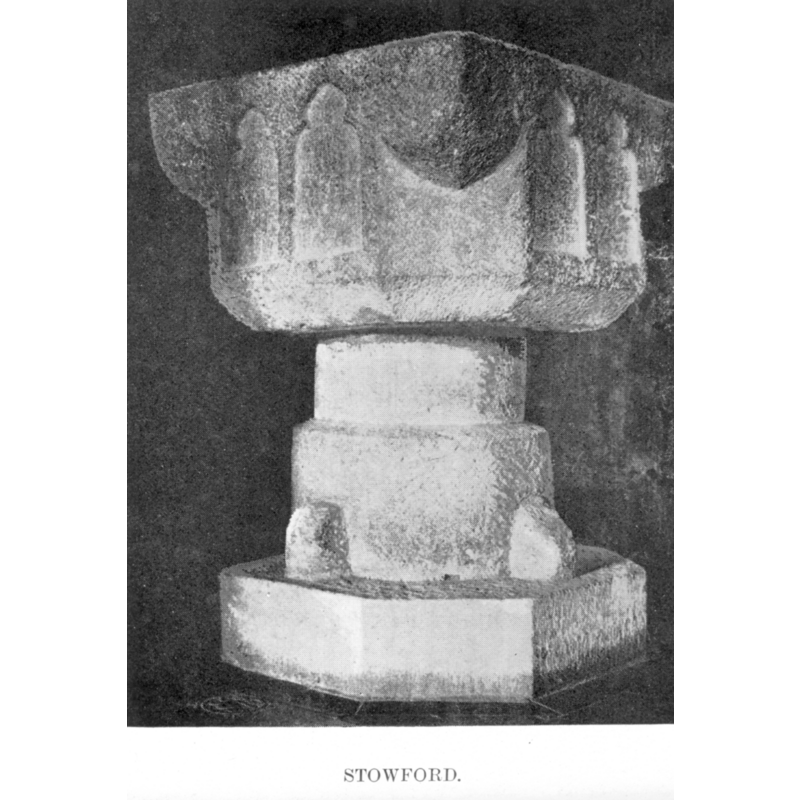Stowford

Image copyright © [in the public domain]
PD
Results: 4 records
B01: design element - architectural - arcade - blind - trefoiled arches - lanceolate arches
B02: design element - motifs - corbel - 4
LB01: design element - architectural - buttress - 4
INFORMATION
FontID: 10427STO
Object Type: Baptismal Font1
Church/Chapel: Parish Church of St. John
Church Patron Saints: St. John
Country Name: England
Location: Devon, South West
Directions to Site: Located off the A30, just E of Lifton, about 10 km ENE of Launceston
Font Location in Church: Inside the church
Century and Period: 12th - 13th century, Transitional
Cognate Fonts: Clarke [cf. infra] groups this font with the ones at Lifton and Maristow
Font Notes:
Click to view
Clarke (1921) writes: "This font is a valuable link in the chain of development; at Lifton and Maristow [cf. Index entries], though they are derived from the cushion bowl and still retain masks at the angles, the semicircular faces are gone, and the general contour is square. At Stowford there are no masks, no carved rim, and no ornamentation except panelling in the shape of trefoil-headed lancets; this feature led the way to the rows of arches, round-topped or pointed, which are so often found in the square fonts of the thirteenth century. The bowl of Stowford font is square in plan; at the four angles, instead of masks as in the two foregoing examples, the stone is cut into a sort of corbel. Each side of these corbels is cushioned, producing a surface flush with the side of the bowl, horizontal at the rim, and semicircular below. The lower part of the corbel consists of two segments of a circle, meeting in an obtuse point at the bottom, with an arris edge passing vertically ou the middle. These corbels measure from 6 to 6 1/2 inches in depth, and below them the stone is chamfered off, making the lower part of the bowl an octagon, with four narrow sides 10 inches wide, and four wide ones, 15 inches. There is no distinct rim as at Maristow and Lifton. The western face is plain, the other faces contain each two lancet-shaped panels, with pointed trefoil heads, the incipient idea of which we noticed [...] at Maristow. At the foot of the bowl the stone is chamfered as at Lifton, still keeping the octagonal form. The shaft and and base are both cylindrical, the top of the base is chamfered, supported by four miniature buttresses, 4 1/2 inches deep; their width averages 3 inches, and projection 3 1/4 inches. The font stands on a modern octagonal plinth; it has a handsome ogee cover, with carved pinnacles and crockets." Noted in Pevsner (1952): "Font. Octagonal and odd, as if it were the late medieval recarving of a Norman font." [NB: there is no rreal contradiction between Clarke and Pevsner's descriptions of the basin: square or octagonal, depending on how the angle carvings are interpreted]
MEDIUM AND MEASUREMENTS
Material: stone
Font Shape: square (mounted)
Basin Exterior Shape: square
Rim Thickness: 8.75 cm [calculated]
Diameter (inside rim): 52.5 cm*
Diameter (includes rim): 70 cm*
Basin Depth: 22.5 cm*
Basin Total Height: 42.5 cm*
Height of Central Column: 16.25 cm*
Font Height (less Plinth): 95 cm*
Notes on Measurements: * [measurements given in inches in Clarke (1922: 223)]
LID INFORMATION
Date: unknown
Material: wood
Notes: [described in Clarke (1921) as "a handsome ogee cover, with carved pinnacles and crockets"]
REFERENCES
Clarke, Kate M., "The baptismal fonts of Devon -- Part IX", 54, Report and Transactions of the Devonshire Association for the Advancement of Science, Literature and Art, 1922, pp. 216-223; p. 223
Clarke, Kate M., "The baptismal fonts of Devon -- Part VIII", 53, Report and Transactions of the Devonshire Association for the Advancement of Science, Literature and Art, 1921, pp. 226-231; p. 230-231 and pl. I (opp. p. 229)
Pevsner, Nikolaus, North Devon, Harmondsworth: Penguin, 1952